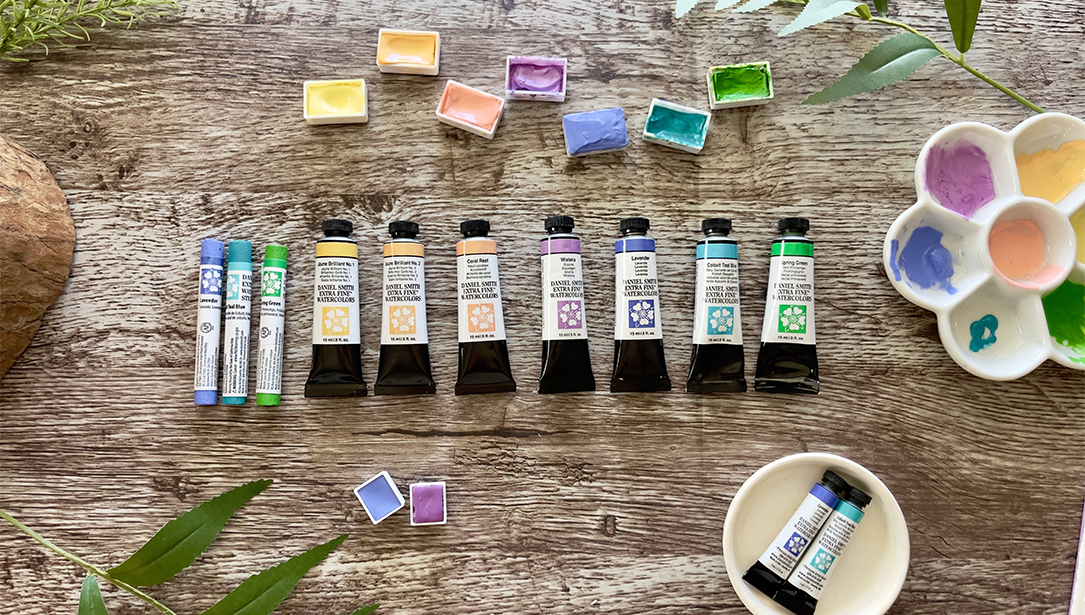Share:
I keep being surprised by DANIEL SMITH paint even though I have been using them for over 7 years. It would be natural to be surprised by new colors but even my signature Artist Dot Card colors keeps astonishing me! Recently I discovered the beautiful granulating effects of Tiger’s Eye Genuine that I am now using when painting cats. It makes a very natural shade of a cat`s soft fur even without additional mixing. It can also be used as an underpainting allowing the application of darker tones over it while it is still moist….
Cats are one of my favorite subjects. I often paint my own cat, Ricci. He doesn’t know, but he’s become a professional model for me. My new tutorial book on how to paint cats has almost half of the images of him as a model. Generally painting cats takes a limited palette of pretty common colors but Tiger’s Eye Genuine makes a dramatic change indeed!

Konstantin Sterkhov’s cat Ricci
I have been painting cats from time to time for years. Sometimes it was a cat of mine or a photograph that I took of someone else’s cat that drove me to this subject. Quite often I use cats as a subject for my workshops. There are lots of students loving cats as well and this subject provides massive possibilities to demonstrate watercolor approaches. Besides, it is always a good change to switch subjects to something nice and comforting!
This spring, I am teaching a workshop at the International Watercolour Masters show in Shropshire, UK on 12-14, May 2020. One of the days we will dedicate to painting cats!
For information on my workshop, please click HERE.
The sketch for this step by step article is just an experimental sketch where I examined the possibilities of a few DANIEL SMITH PrimaTek colors. I wanted to achieve the softness of a cat’s fur with granulation and a wet surface. That purpose is perfectly fulfilled with Tiger’s Eye Genuine. For the background I mixed a couple of colors, both of them granulating, Bloodstone Genuine and Shadow Violet. They created a nice, cool color with a strong texture. The granulating effect was astonishing even without any additional medium!
For the nose and mouth I mixed Wisteria and Sedona Genuine which gave me the fine and delicate color of a cat’s wet tongue and sensitive nose. The mixture came out very fresh and bright.

Step 1
Step 1. Right after drawing the outlines, I apply some masking fluid. I do it only in tiny little spots and lines like whiskers and sometimes blacks in the eyes.

Step 2
Step 2. I wet the paper surface partly. I do it in the areas where I want to create an effect of soft fur. The ears and area around the eyes I leave dry. First, I apply a light neutral color, Tiger’s Eye Genuine, it granulates nicely.

Step 3
Step 3. Next step is making a darker pattern. Here I apply a stronger mix of Tiger’s Eye Genuine and Neutral Tint, also Burnt Umber for the nose. I do it while the previous wash is still moist. Also, I add a bit of color to the ears – with a mix of Wisteria and Sedona Genuine.

Step 4
Step 4. Now it is time for details. My next step is the eyes and the mouth. I do them quite precisely. The mixture for the nose, tongue and mouth is also Sedona Genuine and Wisteria in various proportions.

Step 5
Step 5. The last step would be the background. I decided to make it fairly dark to make a negative shape. I made a mixture of Bloodstone Genuine, Neutral Tint and Shadow Violet. That mix created a wonderful granulation. To make soft, outer borders, I wet the paper a bit of a distance from the cat so that the edges of the cat and the background show contrast, and the tone is fading towards the edges of the sheet. Then I soften the edges with the cat in the shadows. Lastly, I remove the masking fluid.

Cat Watercolor Sketch by Konstantin Sterkhov







